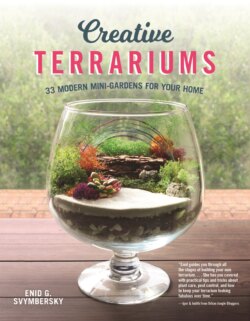Читать книгу Creative Terrariums - Enid G. Svymbersky - Страница 6
На сайте Литреса книга снята с продажи.
INTRODUCTION
ОглавлениеI grew up in a not-so-bad, but also not-sonice, part of Los Angeles. Describing it as “concrete jungle” would be putting it mildly. Trees, hedges, and flowerbeds were practically nonexistent in my neighborhood. That is, until you reached my house. Picture a perfectly manicured lawn, multicolored rose bushes and hydrangeas, and an incorrigible rubber tree that needed pruning all the time, not to mention a ginormous avocado tree in the backyard that could be seen from the street threatening to devour the power lines. The neighbors hated us. They lived in constant fear that our trees’ roots would crack their precious concrete. They were a constant nuisance to my parents. On the flip side, we frequently had strangers knocking on our door asking for avocados and growing advice. These were more our type of people and I always watched my grandparents or parents (depending on who was home) invite them inside. The inside of our house was no different from the outside. My grandmother’s devil’s ivy (Epipremnum aureum) grew rampant all over the living room. In true jungle fashion, it trailed up the walls and around the perimeter of the ceiling in the most breathtaking way. Anyone we invited into our home was instantly fascinated by our wacky way of life.
Always chasing greener pastures, I attended UC Davis, a school known for agriculture and its arboretum that spans more than 5,300 acres. To this day, I have never lived on a greener patch of heaven on earth than during those years. If I was better at math I would probably be telling you about my days learning about chemistry and botany, but instead I was most at home at the school’s craft center. In exchange for free classes, I volunteered to check out tools to the woodworkers, sell clay to the wheel throwers, and set up the chemical baths for the photographers. This is when crafting and making things with my hands really became a passion for me.
Years later, I decided to do what everybody does when they have a passion for something: I started a blog! Living in Los Angeles again, and working a 9-to-5 job, I needed a creative outlet. I was fortunate to find an online community of crafters and plant enthusiasts who felt the same way I did. Then opportunity struck—not for me, but for my husband. He was offered a great job in the San Francisco Bay Area, so we immediately packed our bags and moved . . . into a 130-square-foot room while we figured out where to live. I very quickly realized that I had never been so devoid of greenery in my life. How could we survive six months in a boring, confined room like this? To bring a little life to the place I started creating mini aeriums (air plant terrariums) and succulent terrariums. No clear container was safe from me! I used whatever I could get my hands on: glass jars, bowls, plastic bottles . . . I even transformed our mini coffeepot into an air plant terrarium (see here). I thought it was the sweetest little thing, and I couldn’t just keep it to myself. I decided to post the picture on my blog, and, before I knew it, it was all over social media. That moment of creativity born of my desperation for some greenery in my life is how I came to write Creative Terrariums.
I would love to share your finished terrarium designs! #creativeterrariumsbook
Maybe you picked up this book because you live in a small apartment and feel that a terrarium would be the perfect complement to your space, or maybe you love the challenge of a good DIY project with your kids, or maybe you’ve killed one too many houseplants (it’s okay, we’ve all been there), and now you’re ready to give terrariums a try!
In these pages you’ll be introduced to 33 step-by-step terrarium projects featuring cacti, succulents, tropical plants, mosses, and air plants, to get you started. You will learn everything you need to know to choose the right vessel, foundation, plants, and decorative elements to confidently bring your own mini landscapes to life. You will learn how to identify symptoms of illness and methods for saying “buh-bye” to unwanted pests. We’ll also cover general care tips and techniques to maintain your terrarium.
Whatever the reason behind you holding this book in your hands, please know that I’m beyond humbled, and I sincerely want to thank you for joining me on this adventure. I wish you lots of fun and happy plant memories ahead.
—ENID
You will learn how to identify symptoms of illness and methods for saying “buh-bye” to unwanted pests.
